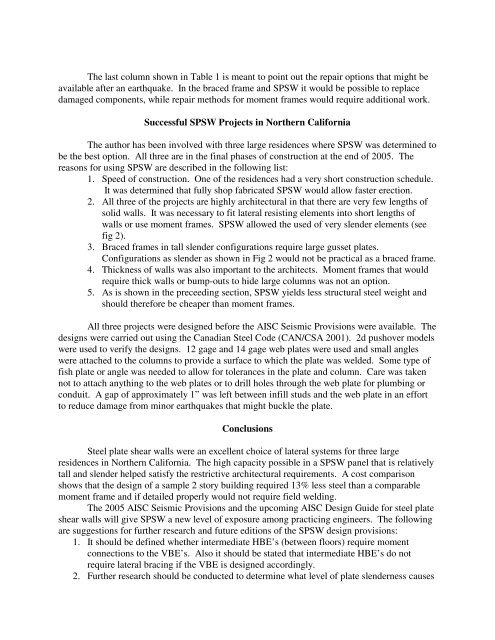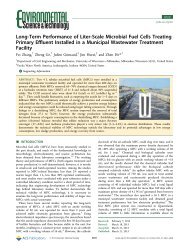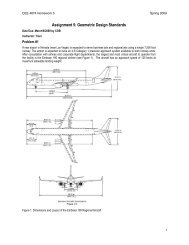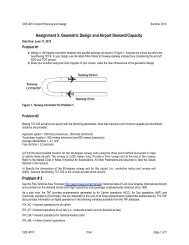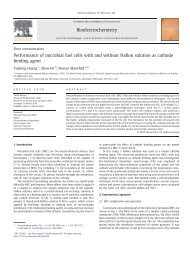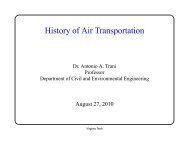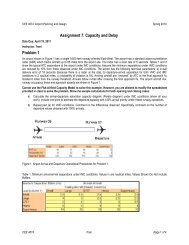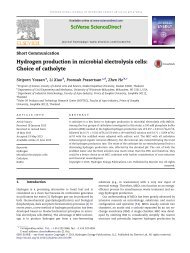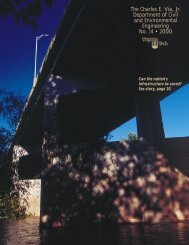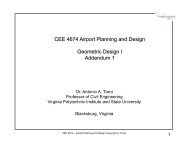Design and Construction of Steel Plate Shear Walls - Eatherton ...
Design and Construction of Steel Plate Shear Walls - Eatherton ...
Design and Construction of Steel Plate Shear Walls - Eatherton ...
Create successful ePaper yourself
Turn your PDF publications into a flip-book with our unique Google optimized e-Paper software.
The last column shown in Table 1 is meant to point out the repair options that might beavailable after an earthquake. In the braced frame <strong>and</strong> SPSW it would be possible to replacedamaged components, while repair methods for moment frames would require additional work.Successful SPSW Projects in Northern CaliforniaThe author has been involved with three large residences where SPSW was determined tobe the best option. All three are in the final phases <strong>of</strong> construction at the end <strong>of</strong> 2005. Thereasons for using SPSW are described in the following list:1. Speed <strong>of</strong> construction. One <strong>of</strong> the residences had a very short construction schedule.It was determined that fully shop fabricated SPSW would allow faster erection.2. All three <strong>of</strong> the projects are highly architectural in that there are very few lengths <strong>of</strong>solid walls. It was necessary to fit lateral resisting elements into short lengths <strong>of</strong>walls or use moment frames. SPSW allowed the used <strong>of</strong> very slender elements (seefig 2).3. Braced frames in tall slender configurations require large gusset plates.Configurations as slender as shown in Fig 2 would not be practical as a braced frame.4. Thickness <strong>of</strong> walls was also important to the architects. Moment frames that wouldrequire thick walls or bump-outs to hide large columns was not an option.5. As is shown in the preceeding section, SPSW yields less structural steel weight <strong>and</strong>should therefore be cheaper than moment frames.All three projects were designed before the AISC Seismic Provisions were available. Thedesigns were carried out using the Canadian <strong>Steel</strong> Code (CAN/CSA 2001). 2d pushover modelswere used to verify the designs. 12 gage <strong>and</strong> 14 gage web plates were used <strong>and</strong> small angleswere attached to the columns to provide a surface to which the plate was welded. Some type <strong>of</strong>fish plate or angle was needed to allow for tolerances in the plate <strong>and</strong> column. Care was takennot to attach anything to the web plates or to drill holes through the web plate for plumbing orconduit. A gap <strong>of</strong> approximately 1” was left between infill studs <strong>and</strong> the web plate in an effortto reduce damage from minor earthquakes that might buckle the plate.Conclusions<strong>Steel</strong> plate shear walls were an excellent choice <strong>of</strong> lateral systems for three largeresidences in Northern California. The high capacity possible in a SPSW panel that is relativelytall <strong>and</strong> slender helped satisfy the restrictive architectural requirements. A cost comparisonshows that the design <strong>of</strong> a sample 2 story building required 13% less steel than a comparablemoment frame <strong>and</strong> if detailed properly would not require field welding.The 2005 AISC Seismic Provisions <strong>and</strong> the upcoming AISC <strong>Design</strong> Guide for steel plateshear walls will give SPSW a new level <strong>of</strong> exposure among practicing engineers. The followingare suggestions for further research <strong>and</strong> future editions <strong>of</strong> the SPSW design provisions:1. It should be defined whether intermediate HBE’s (between floors) require momentconnections to the VBE’s. Also it should be stated that intermediate HBE’s do notrequire lateral bracing if the VBE is designed accordingly.2. Further research should be conducted to determine what level <strong>of</strong> plate slenderness causes


